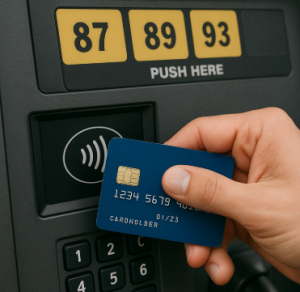Virtual Cards: A Safer Future for Digital Payments
According to a recent article released by PYMNTS, Mastercard has launched “widescale global availability” of an enhanced automated virtual card solution named Mastercard Receivables Manager. New proficiencies in securing card-on-file data and multi-language aid in supporting the digital commerce processes around the world.
As B2B digital payments grow in popularity, exciting news such as Mastercard's announcement of advancements in securely transmitting credit card data will benefit all consumers. The PYMNTS Intelligence report, “Digital Payments Evolution: Virtual Cards Poised to Take Off,” found that 42% of consumers in the United States had used a virtual card for online purchases and subscriptions. The report continues to state that more than half of U.S. consumers store a minimum of one card in digital wallets such as Apple Pay or Google Wallet.
Is a virtual card the same number as my physical card?
Short answer - no. A virtual card has its unique 16-digit number, expiration date, and CVV that is linked to your actual card or bank account. Therefore, the virtual card acts as a secure proxy, keeping your actual account details hidden from merchants or potential hackers.
How does it create a more secure transaction?
Many virtual cards reduce potential fraud by setting limitations against unauthorized use. Customizable controls enable consumers to create single-use, multi-use, or merchant-specific cards, depending on the issuer and the intended purpose. Setting preferences such as spending limits, expiration dates, and merchant restrictions will add another layer of security.
What happens if the information is compromised?
The consumer can cancel or generate a new number instantly, without replacing their physical card. Similar to tokenization, the actual cardholder's account number is encrypted, which means no actual card data is transmitted.
How do consumers create a virtual card?
Many major banks, credit card companies, and third-party apps offer virtual cards. Log in to your bank or card issuer account via a website or mobile app and navigate to the “card controls” section, set preferences, and select “Generate”. Use this number as the credit card information for online purchases and subscriptions.
Apps like Privacy.com, Revolut, Venmo Credit, and Apple Card allow you to link your funding source (bank account or card). Choose options such as one-time use or reusable. Copy the card details and use them during checkout.
In conclusion, as the shift toward digital payments accelerates, virtual cards are proving to be a powerful tool for secure, flexible, and efficient transactions. With major players like Mastercard leading innovation in this space, both businesses and consumers stand to benefit from enhanced fraud protection and greater control over how payments are made and managed. Whether for online purchases, subscriptions, or B2B transactions, virtual cards are shaping the future of secure commerce.
Are Tap-to-Pay Stickers at Gas Pumps a Scam?
Here’s What You Should Know.

Every day, scammers devise new ways to trick consumers. With constant text messages, social media posts, and viral videos fueling fear, it’s challenging to separate fact from fiction. A recent video circulating online sparks concerns about tap-to-pay stickers at gas stations. For years, experts have warned consumers about fraud tactics, such as skimming devices hidden in card readers.
A key tip: check the tamper-evident seal on the pump. If the seal is broken or missing, the pump may have been compromised.
What about the focus on the sticker itself?
According to Google’s AI Overview,
“Stickers placed over tap-to-pay devices at gas pumps are generally legitimate, not a scam. They are often replacement stickers used by gas stations to maintain visibility of payment options, not to steal data. While the circulation of these stickers online has sparked fears of a scam, officials have clarified that the stickers are typically standard industry replacements for worn-out or damaged terminals.”
In other words, most of these stickers are harmless. However, if you notice the tap-to-pay option isn’t working, and the chip reader also fails, it’s best to go inside the store to complete your transaction. Avoid swiping your card, as the magnetic stripe is more vulnerable to skimming devices.
Red Flags: Watch out for stickers promoting a QR code or mobile payment apps, such as Venmo. They are not part of standard pump hardware and should be reported to the station attendant immediately.
Is tap-to-pay the safest option?
Yes. A recent ATMIA (ATM Industry Association) article cited the Financial Crimes Intelligence Center (FCIC) in Tyler, Texas, confirming:
“While we all need to stay vigilant as criminals become more savvy, there are no legitimate instances reported where ‘tap-to-pay stickers’ have been used to steal data,” said Jeff Roberts, FCIC Intelligence Operations Captain.” The article continues to say "tap-to-pay option at fuel pumps, especially when using a payment app, remains the safest method.”
Here's why: Tap-to-pay cards use a small chip and antenna to communicate with payment terminals using radio frequency identification (RFID) or near-field communication (NFC) technology. These systems don’t transmit the actual cardholder’s account number. Instead, they use tokenization, which turns sensitive data into a unique, encrypted code that protects your information during wireless transmission. This makes tap-to-pay one of the most secure payment methods available.
The bottom line.
In today’s digital world, where misinformation spreads quickly, staying informed and cautious is your best defense.
-
Learn how tap-to-pay works
-
Inspect the pump before paying
-
Avoid using the magnetic stripe
-
Report anything that seems off
Stay smart, stay secure!
Have questions about secure payment options? Contact us today.
Follow us for more payment safety tips and share this article to help others pump with confidence.


